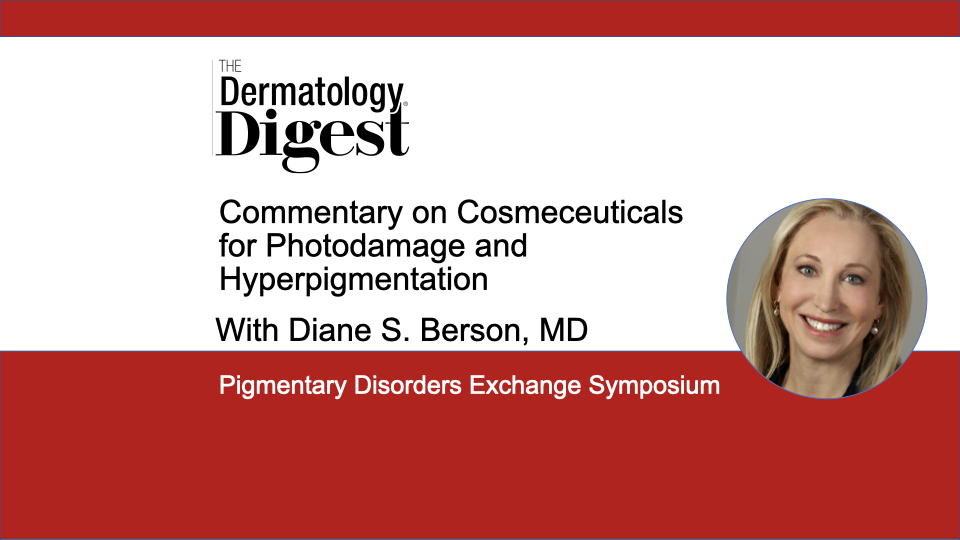Dr. Diane Berson discusses cosmeceutical ingredients that target pigmentary issues, including those that decrease melanin production, interfere with melanin transfer, or remove melanin.
Diane S. Berson, MD, Associate Clinical Professor of Dermatology, Weill Medical College, Cornell University, New York, New York
“We no longer have the ability to use hydroquinone for over-the-counter skin care products that target pigmentation,” said Diane S. Berson, MD, who presented “Cosmeceuticals for Photodamage and Hyperpigmentation” at the inaugural Pigmentary Disorders Exchange Symposium in Chicago.
“This has led to the development of ingredients that can be incorporated into cosmeceuticals and skin care products to help with pigmentary issues, whether it’s evening the tone of the skin or fading hyperpigmentation… in patients with photodamage, freckling, post-inflammatory hyperpigmentation, and certainly for those with melasma.”
Those ingredients include antioxidants, anti-inflammatories, ingredients that might interfere with melanin production, others that might interfere with the transfer of pigment, those that improve pigmentation by exfoliation, as well as a couple of new ingredients that destroy pigment, said Dr. Berson.
Ingredients that decrease melanin production include antioxidants, such as vitamin C, kojic acid, azelaic acid, arbutin, and licorice extract, said Dr. Berson.
“Newer ingredients that we’re seeing a lot of success with are cysteamine hydrochloride (HCL), tranexamic acid, which can be used both topically and orally, and even phenylethyl resorcinol.”
New cosmetically elegant products have eliminated the previous odor and potential skin irritation associated with cysteamine HCL, she said.
“Of course, we often start this with short contact therapy but have had a lot of success with cysteamine HCL.”
More products with tranexamic acid—usually from 2% to 6% of the active ingredient—are becoming available, said Dr. Berson.
“This has been helpful. There are those who are prescribed oral tranexamic acid, but that should only be done by a board-certified dermatologist who does the appropriate evaluation. Obviously if the patient has a coagulopathy, you might not want to use the oral form.”
Niacinamide and soy are among the ingredients that interfere with melanin transfer from melanosomes to keratinocytes, said Dr. Berson.
“Niacinamide, a B vitamin, is a potent anti-inflammatory and antioxidant, so it’s also a helpful ingredient for those who have hyperpigmentation.”
When it comes to treating primarily epidermal pigment, Dr. Berson said dermatologists might recommend keratolytics, which aid with keratinocyte desquamation.
“These include the topical retinoid and retinol products, and, of course, the alpha hydroxy acids, such as glycolic acid, lactic acid, and salicylic acid.”
There are a few new ingredients that appear promising for skin lightening, including lotus sprout extract, which helps in phagosome destruction and melanosome degradation, said Dr. Berson.
“There is another new ingredient called malassezin. As we know when we see patients with tinea versicolor, they develop hypopigmented patches on the skin. So, what a great idea to try to isolate malassezin, which is produced by Malassezia furfur. It has since been isolated and is going to be available in a topical cosmeceutical product to lighten pigmentation.”
Comprehensive Care
Today’s skin care product lines contain various combinations of these ingredients and can be used in conjunction with prescription hydroquinone, said Dr. Berson.
“A discussion of pigmentation would not be complete without addressing the need for thorough sun protection along with sun avoidance. We recommend broad spectrum protection with UVA and UVB.”
According to Dr. Berson, filtering out longwave UVA and visible light is also important.
“The recent addition of iron oxides in tinted sunblock formulations can help absorb both visible and longwave UVA light.”
Disclosures: Dr. Berson has ties with Allergan, Procter and Gamble, L’Oreal, Ortho Derm, Revance, CeraVe, La Roche Posay, Alumier, Crown, Evolus, Cassiopea, Biopelle, Regimen Pro, CLN, and Almirall.


